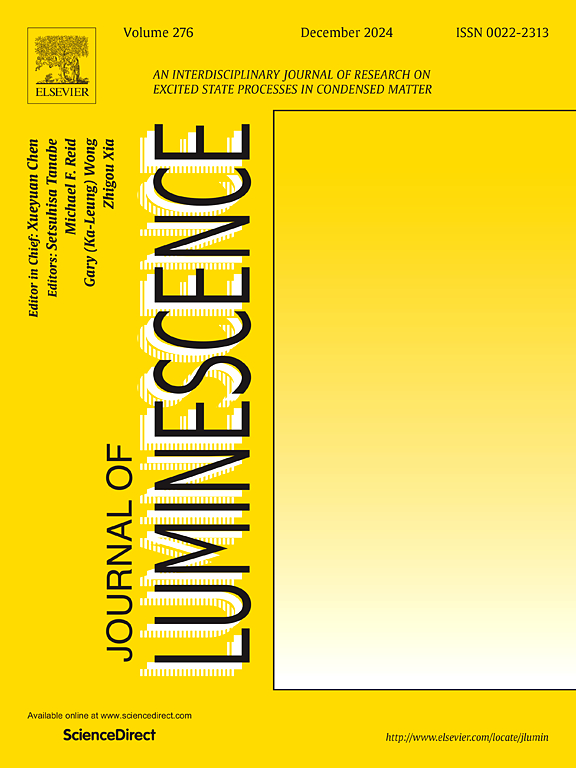Novel Dy3+ -doped CaYF5 phosphor: Structural and optical properties for solid-state lighting applications
IF 3.3
3区 物理与天体物理
Q2 OPTICS
引用次数: 0
Abstract
In this work, Ca(1-x) YF5: xDy3+ (x = 1 to 3 mol% in steps of 0.5) phosphors were synthesized via the chemical co-precipitation technique. XRD analysis confirmed that both doped and undoped samples exhibit a consistent face-cantered cubic (FCC) phase with an Fm-3m space group, further validated by Rietveld refinement. SEM and EDX were employed to analyse the structural features and chemical composition of the prepared phosphor, respectively. FTIR spectroscopy was employed to identify chemical bonding and corresponding vibrational modes. DRS technique was utilized to estimate the energy band gap (Eg = 5.60 eV for pure CaYF5 and Eg = 6.34 eV for CaYF5:2mol% Dy3+), as well as optical parameters, such as the refractive index (RI = 1.92 for pure CaYF5 and n = 1.83 for CaYF5: 2 mol% Dy3+).Moreover, we found that the Dy3+-ligand bond in the CaYF5 phosphor host is primarily ionic in nature. Photoluminescence (PL) studies revealed a primary excitation peak at 353 nm, corresponding to the 6H15/2 6P7/2 transition. The emission spectra exhibited four distinct peaks at 481(blue) nm,491 nm(blue), 579 nm (yellow), and 673 nm (red), corresponding to Dy3+ ion transitions 4F9/2 6Hj, (J = 15/2,13/2,11/2). Based on Dexter's theory we observed luminescence quenching occurred at 2 mol% of Dy3+, which is due to dipole-quadrupole interactions. The optimized phosphor sample exhibited key characteristics such as CIE (0.4829, 0.4907), and CCT ( 2950 K), and high colour purity (92.2 %). Furthermore, TDPL studies demonstrated excellent thermal stability, showing consistent luminescence across different temperatures. The calculated activation energy of 0.1564 eV and corresponding CIE reveals slight change in wavelength observed at high temperature (578.4 nm at 298 K to 577.4 nm at 498 K). It highlights its potential for solid-state lighting applications.

新型掺杂Dy3+的CaYF5荧光粉:用于固态照明的结构和光学特性
本文采用化学共沉淀法合成了Ca(1-x) YF5: xDy3+ (x = 1 ~ 3mol %,步长0.5)荧光粉。XRD分析证实,掺杂和未掺杂样品均表现出具有Fm-3m空间基的一致面心立方相(FCC), Rietveld细化进一步验证了这一点。利用SEM和EDX对制备的荧光粉的结构特征和化学成分进行了分析。FTIR光谱分析了其化学键和相应的振动模式。利用DRS技术估计了能带隙(纯CaYF5 Eg = 5.60 eV, CaYF5:2mol% Dy3+ Eg = 6.34 eV)和折射率(纯CaYF5 RI = 1.92, CaYF5:2mol% Dy3+ n = 1.83)等光学参数。此外,我们发现CaYF5荧光粉宿主中的Dy3+-配体键本质上主要是离子键。光致发光(PL)研究发现,在353nm处有一个初级激发峰,对应于6H15/2→6P7/2跃迁。发射光谱在481(蓝色)nm、491 nm(蓝色)、579 nm(黄色)和673 nm(红色)处有4个明显的峰,对应于Dy3+离子跃迁4F9/2→6Hj, (J = 15/2,13/2,11/2)。根据Dexter的理论,我们观察到在2mol %的Dy3+中发生了发光猝灭,这是由于偶极子-四极子相互作用。优化后的荧光粉样品具有CIE(0.4829, 0.4907)和CCT (~ 2950 K)等关键特性,并且具有较高的色纯度(92.2%)。此外,TDPL研究显示出优异的热稳定性,在不同温度下显示一致的发光。计算得到的活化能为0.1564 eV,对应的CIE表明,在高温下观察到的波长(298 K时为578.4 nm至498 K时为577.4 nm)发生了轻微变化。它突出了固态照明应用的潜力。
本文章由计算机程序翻译,如有差异,请以英文原文为准。
求助全文
约1分钟内获得全文
求助全文
来源期刊

Journal of Luminescence
物理-光学
CiteScore
6.70
自引率
13.90%
发文量
850
审稿时长
3.8 months
期刊介绍:
The purpose of the Journal of Luminescence is to provide a means of communication between scientists in different disciplines who share a common interest in the electronic excited states of molecular, ionic and covalent systems, whether crystalline, amorphous, or liquid.
We invite original papers and reviews on such subjects as: exciton and polariton dynamics, dynamics of localized excited states, energy and charge transport in ordered and disordered systems, radiative and non-radiative recombination, relaxation processes, vibronic interactions in electronic excited states, photochemistry in condensed systems, excited state resonance, double resonance, spin dynamics, selective excitation spectroscopy, hole burning, coherent processes in excited states, (e.g. coherent optical transients, photon echoes, transient gratings), multiphoton processes, optical bistability, photochromism, and new techniques for the study of excited states. This list is not intended to be exhaustive. Papers in the traditional areas of optical spectroscopy (absorption, MCD, luminescence, Raman scattering) are welcome. Papers on applications (phosphors, scintillators, electro- and cathodo-luminescence, radiography, bioimaging, solar energy, energy conversion, etc.) are also welcome if they present results of scientific, rather than only technological interest. However, papers containing purely theoretical results, not related to phenomena in the excited states, as well as papers using luminescence spectroscopy to perform routine analytical chemistry or biochemistry procedures, are outside the scope of the journal. Some exceptions will be possible at the discretion of the editors.
 求助内容:
求助内容: 应助结果提醒方式:
应助结果提醒方式:


